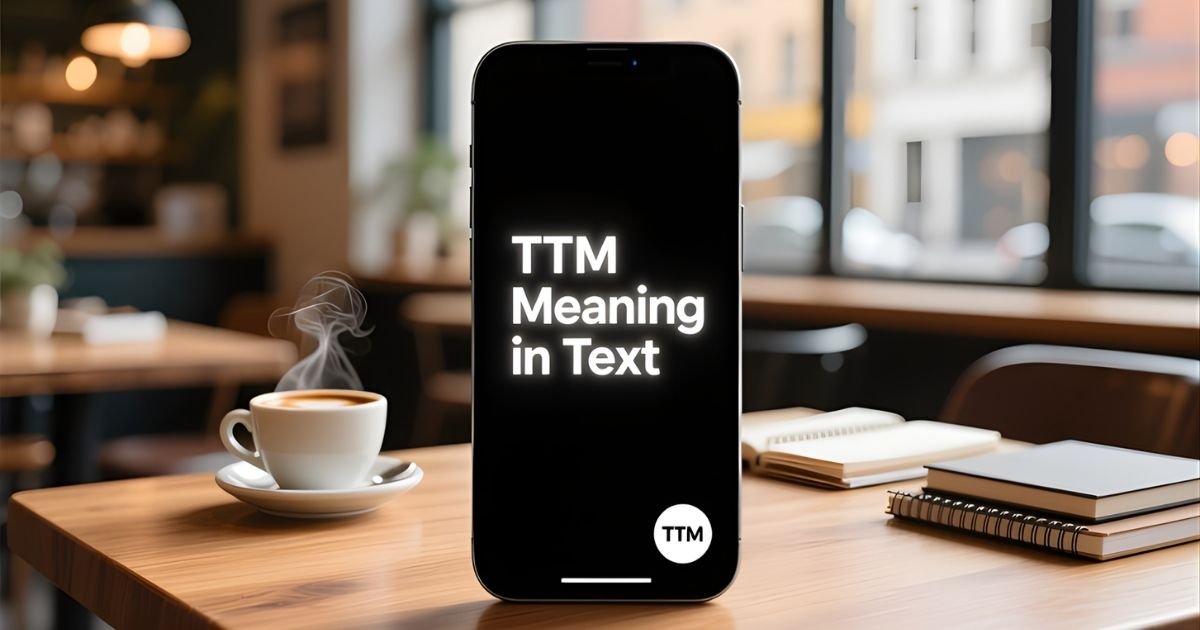You just got a text that says “TTM” and you’re staring at your phone like it’s written in code.
Is someone asking you to talk?
Are they mad at you?
Maybe it’s some business term you missed in a meeting?
Here’s the deal: TTM usually means “Talk To Me” in casual texting.
It’s someone’s way of saying they want to chat, catch up, or hear what’s on your mind.
But that’s not the whole story because TTM can mean different things depending on where you see it and who’s using it.
This guide breaks down everything you need to know about this popular text abbreviation, how people actually use it, and how to respond without looking clueless.
Meaning & Definition of TTM
Primary Meaning
TTM stands for “Talk To Me” in most digital communication slang situations.
When someone sends you TTM, they’re opening the door for conversation.
They might be bored, curious about your day, or just want to connect.
It’s a simple invitation that says “I’m here and I want to hear from you.”
Think of it as a casual nudge in the online messaging behavior world.
No pressure, just an open channel for whatever’s on your mind.
Secondary Meanings
TTM isn’t a one-trick pony in the internet language trends universe.
Depending on the context, it can mean completely different things:
In Business & Finance:
- Trailing Twelve Months – a way companies measure performance over the past year
- Time To Market – how long it takes to launch a product
In Other Fields:
- Through The Mail – often used by collectors who trade items by mailing them
- Targeted Temperature Management – a medical term for controlling body temperature
- Test Track Model – used in engineering and product testing
The key is reading the situation.
If your friend texts “TTM” at 11 PM, they’re not asking about quarterly earnings.
Background & Origin
The “Talk To Me” acronym emerged from the same place most texting slang was born: the need for speed.
Back when phones had number keypads and you had to press “2” three times just to type the letter “C,” every character mattered.
Young people started creating short-form communication shortcuts to save time and thumb energy.
TTM appeared alongside classics like LOL, BRB, and TTYL as part of the youth internet communication revolution.
As smartphones took over and typing got easier, these abbreviations stuck around because they add personality and casual vibe to messages.
Today’s Gen Z slang meanings keep evolving, but TTM remains a solid choice for starting conversations without sounding too formal or desperate.
Usage in Different Contexts
1. In Casual Texting
This is where TTM lives most of the time in the casual message slang world.
Your friend might drop a “TTM when you’re free” after you’ve been quiet for a few days.
It’s low-pressure and friendly, not demanding like “CALL ME NOW.”
Example: “Hey, haven’t heard from you in a while, TTM whenever!”
It works because it respects your time while showing they care enough to reach out.
2. In Friend Groups
In group chats, someone might throw out “TTM” when they need advice or want opinions on something.
It’s basically saying “I need your thoughts, people.”
Example: “Thinking about dying my hair purple, TTM what you think”
The conversational abbreviations style here creates engagement without writing a paragraph.
3. In Flirting or Dating
This is where TTM gets interesting in the flirty tone in digital text game.
When someone you’re interested in sends “TTM,” it often means they want your attention specifically.
It’s more personal than a generic “hey” and shows they’re thinking about you.
Example on dating apps: “You seem interesting, TTM about your travel stories”
The emoji-supported messages might include a 😊 or 💬 to soften it further.
It’s their way of saying “I want to know you better” without being too forward.
4. In Work or Professional Use
Hold up before you text your boss “TTM” about the quarterly report.
In professional settings, TTM usually means Trailing Twelve Months or Time To Market, not “Talk To Me.”
If you see it in an email or business document, it’s probably about TTM in finance metrics or project timelines.
Example: “Our TTM revenue shows 15% growth”
Save the casual “Talk To Me” version for coworkers you’re actually friends with outside work.
Meanings Across Platforms
TTM on Snapchat: Usually means “Talk To Me” and often comes with a selfie or Story reply.
TTM on Instagram: Shows up in DMs when someone wants to move from likes to actual conversation.
TTM on TikTok: Appears in comments when viewers want creators to address a topic or respond.
TTM on WhatsApp: Same as regular texting – an invitation to chat or catch up.
TTM in dating apps: Almost always means “Talk To Me” with romantic or friendly interest implied.
The meaning variation across platforms stays pretty consistent for the casual version.
Business meanings of TTM stick to emails, reports, and professional documents.
Other Fields Where TTM Has Different Meanings
Collectors & Hobbyists: Through The Mail (TTM) is huge in sports card collecting and autograph hunting.
People send items to celebrities or athletes hoping they’ll sign and return them.
Medical Field: Targeted Temperature Management helps doctors treat patients after cardiac arrest by controlling body temperature.
Engineering & Manufacturing: Test Track Model refers to prototype testing before full production.
Marketing: Time To Market measures how fast a company can develop and launch new products.
Understanding these context-based meanings prevents awkward mix-ups.
Common Misconceptions & Mistakes
Mistake #1: Thinking TTM always means “Text To Me”
Wrong. It’s “Talk To Me” – broader than just texting, includes any form of communication.
Mistake #2: Using TTM in formal business emails when you mean “please contact me”
This makes you look unprofessional unless everyone knows you well.
Mistake #3: Confusing TTM with TTYL (Talk To You Later)
These are opposites – one starts a conversation, the other ends it.
Mistake #4: Assuming TTM in a work document means “Talk To Me”
Always check context before responding to avoid looking confused.
Similar Terms & Alternatives
HMU (Hit Me Up): More casual, often used for making plans
DM Me: Specifically asks for a direct message on social media
TTYL (Talk To You Later): Used to end conversations, not start them
WYD (What You Doing): Another conversation starter but more direct
LMK (Let Me Know): Asks for specific information rather than open conversation
The difference between TTM and HMU is subtle – HMU feels more action-oriented while TTM is conversational.
How to Respond to “TTM”
If you want to chat: “Hey! What’s up?” “Sure, what’s on your mind?” “Always! What’s going on?”
If you’re busy but interested: “Will do in an hour!” “Let me finish this and I’ll call you” “Text me and I’ll respond when I can”
If you’re not interested (politely): “Caught up right now, maybe later” “Pretty busy today, sorry”
In flirty situations: “You have my attention 😊” “I’m listening…” “Tell me everything”
The key is matching their energy and being honest about your availability.
Differences From Similar Words
TTM vs TTYL: TTM opens conversations; TTYL closes them.
TTM vs DM Me: TTM works anywhere; DM Me is platform-specific.
TTM vs HMU: TTM wants conversation; HMU wants plans or action.
TTM vs WYD: TTM is open-ended; WYD asks a specific question.
Understanding these similar terms and alternatives helps you pick the right one for each situation.
Relevance in Online Conversations & Dating Apps
TTM has staying power in the modern text communication landscape because it’s versatile.
On dating apps, it’s a softer opener than “Hey” because it implies you actually want meaningful conversation.
In friend groups, it creates social media engagement language without demanding immediate attention.
The emotional tone detection is neutral – not too eager, not too cold.
It works across age groups because it’s simple enough for anyone to understand.
Unlike newer slang that gets outdated in months, TTM has been around long enough to be universally recognized.
Popularity & Trends Over Time
TTM peaked during the early texting era when character limits mattered.
It dipped slightly when smartphones made typing easier and people got lazier with abbreviations.
But recently, there’s been a comeback in trending texting acronyms as people seek authentic, casual ways to connect.
The linguistic evolution online shows that simple, clear abbreviations like TTM survive while complex ones fade.
Gen Z uses it, Millennials understand it, and even older generations recognize it.
The business meanings of TTM (Trailing Twelve Months, Time To Market) have grown more common as these metrics became standard.
Google Trends shows steady searches for “what does TTM mean in text” year-round, proving it’s still relevant.
FAQ’s
What does TTM meaning in text?
TTM means “Talk To Me” in casual texting. It’s an invitation to start a conversation or chat about anything freely.
How do I respond to TTM?
Respond with “Hey, what’s up?” or “Sure, what’s on your mind?” Match their energy and show you’re interested in chatting.
Is TTM used in professional settings?
In business, TTM means “Trailing Twelve Months” or “Time To Market.” Save casual “Talk To Me” for friends only.
What’s the difference between TTM and HMU?
TTM wants open conversation while HMU means “Hit Me Up” for making plans. TTM is conversational; HMU is action-oriented.
Can TTM mean something other than Talk To Me?
Yes. TTM can mean “Through The Mail,” “Targeted Temperature Management,” or financial terms depending on context and platform used.
Conclusion
TTM is one of those digital slang terms that survived the evolution from flip phones to smartphones because it serves a real purpose.
When someone texts you TTM, they’re usually saying “Talk To Me” – an open invitation for conversation without pressure.
The beauty of TTM is its simplicity in informal communication style.
It works in casual chats, friend groups, flirty conversations, and even has separate meanings in business contexts.
Remember: context is everything in the pragmatic meaning in texting world.
If your friend sends it at midnight, they want to chat.
If your boss includes it in a report, they’re talking about financial metrics.
Next time TTM pops up in your messages, you’ll know exactly what it means and how to respond.
Now go ahead and use this knowledge to navigate your online discourse patterns like a pro.
And if someone asks what TTM means, you can explain it without pulling up Google.
That’s the power of understanding modern text communication – you’re never lost in translation.

James Smith is the creative force behind Celebrity Meaning, bringing fans closer to their favorite stars by revealing the hidden meanings behind celebrity names. With a flair for fun facts and trending insights, James Smith keeps the site fresh, engaging, and full of star-powered stories!











